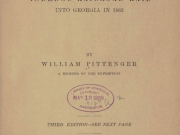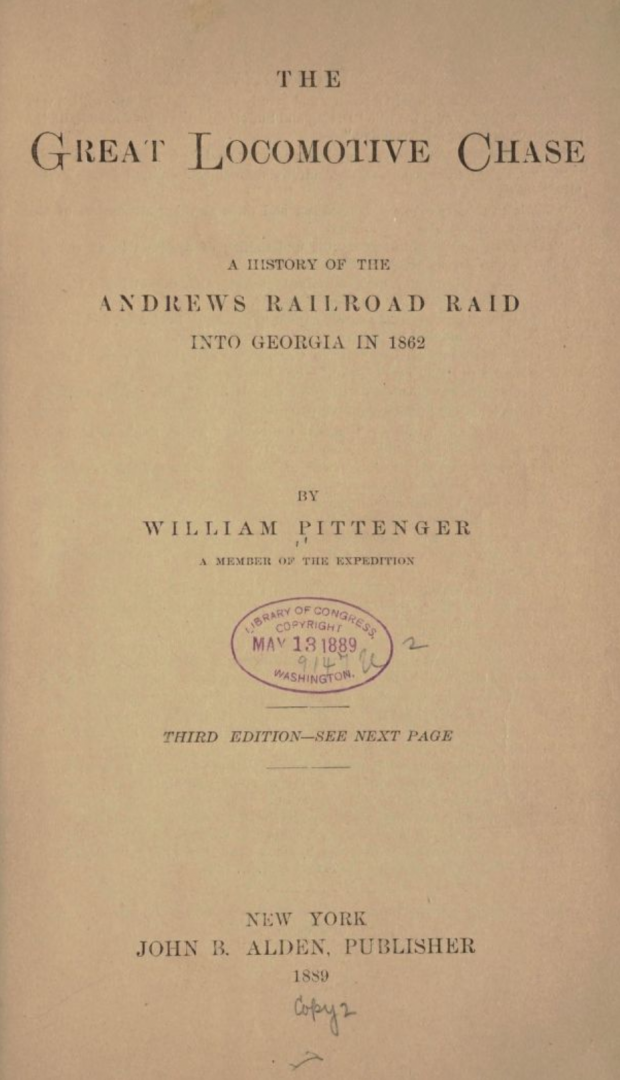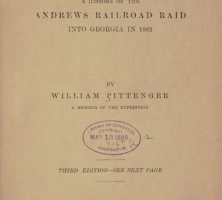The Great Locomotive Chase is an action-adventure film produced by Walt Disney in 1956. To date it is the last of several films depicting the Andrews Raid of 1862, which took place in north Georgia during the Civil War (1861-65).
On April 12, 1862, Union raiders staged a daring seizure of a Confederate train pulled by the General, a locomotive headed north from Big Shanty (present-day Kennesaw, in Cobb County) toward Chattanooga, Tennessee, and the Union lines. The Disney film was produced nearly thirty years after The General (1927), a silent-film version of the story by comedian Buster Keaton, and offers a far more serious and straightforward telling of these events. While Keaton casts the Confederates as the heroes of his narrative, The Great Locomotive Chase focuses on the raiders and portrays their leader, James J. Andrews, as the film’s protagonist.
The Source Material
William Pittenger, a participant in the Andrews Raid, wrote several narrative accounts of the event. Born in Ohio in 1840, Pittenger joined the Union army in 1861 and the following year rode north in a Western and Atlantic boxcar during the raid, until he was captured by Confederate forces. In 1864 he became a Methodist minister and subsequently spent much of his life attending veterans’ reunions and writing a series of books chronicling the raid.

Courtesy of Library of Congress
Pittenger’s first book about the raid, Daring and Suffering, appeared in 1863, and he revised the work several times. He later admitted that “Daring and Suffering, like a number of similar sketches published in newspapers, magazines, and pamphlets, was a hasty narrative of personal adventure, and made no pretense of completeness.” His next work about the raid, Capturing a Locomotive: A History of Secret Service in the Late War (1881), greatly exaggerates Pittenger’s own importance in the raid. His last major work, The Great Locomotive Chase: A History of the Andrews Railroad Raid into Georgia in 1862 (1889), is dedicated to “The Grand Army of the West, which, under command of General Sherman, in one hundred days of continuous battle, followed us and conquered where we only dared.”
The Film
The Great Locomotive Chase, directed by Francis D. Lyon, is a fairly accurate depiction of William Pittenger’s various accounts of the raid; in fact, the film includes a shot of Pittenger’s book cover, but not of the raid itself. The action sequences were filmed in Habersham and Rabun counties in northeast Georgia, and the tracks of the old Tallulah Falls Railroad were brought back into service for the locomotive chase scenes. Walt Disney himself spent several weeks on location in the north Georgia mountains.
The film begins with Edwin M. Stanton, the secretary of war, presenting the Congressional Medal of Honor to the surviving members of the raid team, including Pittenger (played by John Lupton), who serves as the film’s narrator. This scene moves quickly into a flashback, with Pittenger introducing civilian James J. Andrews (played by longtime Disney stalwart Fess Parker) as the “man of mystery” who conceives of the daring scheme; Andrews is quickly established as the film’s hero. The narrative details Andrews’s recruitment of his volunteer raiders and dramatizes their secret advance into Georgia, the taking of the locomotive, the suspense-filled chase that ensues, and the ultimate failure of the mission, culminating in the execution of Andrews and other captives.
While Pittenger’s early books vilified the Confederacy, in his later life he gave high praise to William Fuller, the Western and Atlantic conductor who doggedly pursued the stolen train. The film reflects this later, more conciliatory attitude, and Fuller (portrayed by Jeffrey Hunter) emerges as a minor hero in his own right. (His character is a more realistic version of the southern protagonist played by Buster Keaton in The General.)
Despite its Northern bias, the film ultimately emphasizes reconciliation between North and South. When Pittenger sees a Confederate soldier, he muses, “That soldier—he’s supposed to be my enemy—I’m supposed to hate him,” but he can’t bring himself to do so. At the end of the film, as Andrews is about to be executed, he shakes hands with Fuller—something that never occurred in real life but is symbolic of the reconciliation between North and South. The film is most critical not of the South but of the dangers of unrestrained emotion. As the Pittenger character notes, “My companion was the giant Bill Campbell—he had a violent temper—one such powder keg could blow the expedition sky-high.”
As the narrator, Pittenger also recognizes the waste and futility of war itself and sees the raid as an attempt to prevent further bloodshed, saying, “I believe in the federal Union, and I hope we can preserve it without any more Shilohs—we could stop it.” Thus, the film is ultimately not about a conflict between North and South but is rather an homage to the little man (or men) who fight the good fight against mass society. The film ultimately emphasizes the individual value of personal honor and bravery in wartime.






